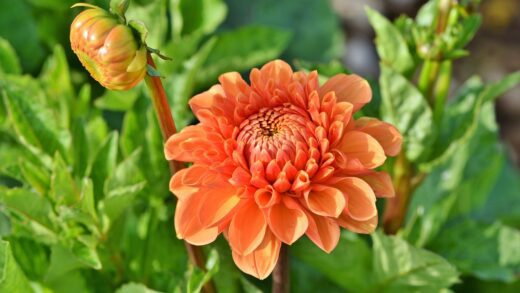While moss rose is celebrated as a low-maintenance plant that thrives on a degree of neglect, strategic pruning and cutting back can significantly enhance its performance, leading to a fuller plant and a more continuous display of flowers. These simple techniques, ranging from the delicate task of deadheading to a more substantial mid-season trim, are not about controlling an unruly plant but about encouraging its natural tendencies for bushy growth and prolific blooming. Understanding when and how to prune allows you to actively shape your moss rose into a healthier, more compact, and floriferous specimen throughout the entire growing season.
The purpose of pruning moss rose
Pruning moss rose is not about formal shaping or size reduction as it might be with shrubs or trees. Instead, the primary purpose of any cutting is to encourage the plant to produce more flowers and maintain a dense, attractive growth habit. The plant’s natural life cycle is geared towards producing flowers, getting them pollinated, and then setting seed. By intervening in this process, you can manipulate the plant’s energy allocation for a better ornamental display.
The most common pruning practice, deadheading, directly serves this purpose. By removing spent flowers before they can develop into seed pods, you send a signal to the plant that its reproductive mission has not yet been accomplished. This encourages the plant to redirect its energy away from seed maturation and back into producing new buds and blooms. This simple act can dramatically extend the flowering period and increase the total number of flowers produced over the season.
Another key goal of pruning is to promote a bushier, more compact form. Left to its own devices, a moss rose plant can sometimes become leggy, with long, trailing stems that have sparse foliage and flowers concentrated at the tips. Pinching back the stem tips or giving the plant a light trim encourages it to branch out from lower down on the stems. This results in more lateral growth, creating a fuller, denser mat of foliage and, consequently, more locations from which new flowers can emerge.
Finally, pruning serves a vital role in plant rejuvenation, particularly in the middle of a long, hot summer. Over time, the initial flush of growth can become tired and less productive. A more significant cutting back can reset the plant, stimulating a fresh wave of vigorous new growth and a subsequent flush of blooms. This “haircut” can transform a straggly, flagging plant back into a vibrant and healthy specimen for the remainder of the season.
More articles on this topic
The technique of deadheading for continuous blooms
Deadheading is the most frequent and arguably the most important pruning task for maximizing the floral display of your moss rose. The process involves the removal of faded or dead flowers. This prevents the plant from expending energy on developing seeds and instead channels that energy into creating new flowers. While it can seem like a meticulous task on a plant with so many small blooms, the results are well worth the effort.
To deadhead effectively, you can use your thumb and forefinger to simply pinch off the spent flower head. For a cleaner cut, a pair of small, sharp scissors or floral snips works very well. It is best to remove not just the dead petals but the entire flower head, including the small swelling at its base where the seed pod would form. Follow the short stem of the faded flower down to where it meets a larger stem or a set of leaves and make your cut there.
While deadheading every single flower every single day is impractical for most gardeners, even a periodic effort can make a big difference. Try to go over your plants once or twice a week to remove the most obvious faded blooms. This regular maintenance will not only boost flower production but also keep your plants looking neat and tidy, preventing the unsightly appearance of shrivelled, brown petals amongst the fresh, vibrant ones.
It is worth noting that some modern moss rose cultivars are “self-cleaning,” meaning the faded flowers drop off cleanly on their own without the need for deadheading. These varieties are bred to continue blooming prolifically without this intervention. However, even on self-cleaning types, a light trim or pinching back can still be beneficial for encouraging a bushier habit, so do not hesitate to groom the plant as needed to maintain its shape and density.
More articles on this topic
Pinching back for bushier growth
Pinching is a gentle pruning technique that is particularly effective on young moss rose plants to encourage a fuller, more branched habit from the very beginning. The process involves removing the very tip of a growing stem. This removes the apical bud, which produces hormones that suppress the growth of lateral buds further down the stem. Once the apical bud is gone, these side buds are stimulated to grow, resulting in two or more new stems branching out from where there was previously only one.
The best time to start pinching back your moss rose is when the seedlings or young transplants are a few inches tall and have several sets of leaves. Using your fingers or a small pair of snips, simply pinch out the top half-inch to one inch of the main stems. This small act will have a significant impact on the plant’s future shape, preventing it from becoming long and leggy and instead promoting a dense, mounded form right from the start.
You can continue to pinch back the tips of any overly long stems throughout the growing season. If you notice a particular stem is outgrowing the others and creating an unbalanced shape, simply pinch it back to encourage it to branch out and fill in. This technique is especially useful for plants in hanging baskets and containers, where a full, cascading habit is highly desirable. Regular pinching ensures a continuous ball of colour rather than long, stringy stems.
This method of pruning is a proactive way to maintain the plant’s appearance. By guiding its growth early on, you can prevent the need for more drastic pruning later in the season. It is a simple, ongoing conversation with your plant, encouraging it to grow in a way that is both healthier for the plant and more aesthetically pleasing in the garden. It turns a potentially gangly plant into a dense, flower-covered cushion.
Mid-season rejuvenation pruning
By the middle of summer, particularly after a massive flush of blooms, moss rose plants can sometimes start to look tired, sparse, and a bit straggly. The flowering may slow down, and the centre of the plant can become open and woody. This is a perfect time for a more substantial rejuvenation pruning to encourage a fresh wave of growth and a second spectacular flower display that will last into the autumn.
This process involves cutting the entire plant back by about one-third to one-half of its height. Using a clean pair of garden shears, give the plant an overall “haircut,” trimming back all the stems evenly. While this may seem drastic, and the plant will look quite bare for a short time, this hard prune stimulates the growth of new, vigorous shoots from the base and sides of the plant. It is a reset button that revitalizes the plant for the second half of the season.
After performing this mid-season trim, it is a good idea to give the plant a deep watering to help reduce stress and provide the moisture it needs to fuel the new growth. If you ever use fertilizer on your moss rose, this would be one of the few times a very light, diluted feeding could be beneficial to support the development of the new shoots and buds. Within a couple of weeks, you will see fresh, dense foliage emerging, quickly followed by a new flush of abundant flowers.
This technique is especially effective for moss rose grown in containers, hanging baskets, or as edging, where a compact and tidy appearance is important. It is a simple solution to the common mid-summer “blahs” that can affect many annual plants. Do not be afraid to be bold with this trim; moss rose is a resilient plant that responds remarkably well to being cut back, rewarding your efforts with renewed vigour and beauty.
End-of-season cleanup
As autumn arrives and the weather cools, the growth of your moss rose will naturally slow down. Pruning at this stage is less about encouraging new growth and more about general tidiness. You can continue to deadhead faded flowers to keep the plant looking its best for as long as possible, right up until the first frost. This ensures you can enjoy every last bloom the plant has to offer before its life cycle comes to an end.
If you wish to save seeds for next year’s garden, you should stop deadheading a section of your plants in late summer or early autumn. Allow the flowers in this section to fade and develop seed pods naturally. This is a form of selective pruning, where you are choosing to let the plant complete its reproductive cycle in a controlled way, ensuring you will have a harvest of viable seeds for the following spring.
Once the first hard frost has occurred, the moss rose plants will be killed off. The succulent foliage will turn black and mushy. At this point, the final pruning task of the season is the complete removal of the dead plant material. Cut the plants back to the ground level and remove all the debris from the garden bed. This is not just for aesthetics; it is a crucial hygiene practice.
This final cleanup removes any potential overwintering sites for pests and fungal diseases, ensuring a healthier start for your garden next spring. By clearing the bed of the old plant matter, you prevent problems before they have a chance to begin. It is the last act of care for your moss rose, concluding the season and preparing the soil for the next year of gardening.


















